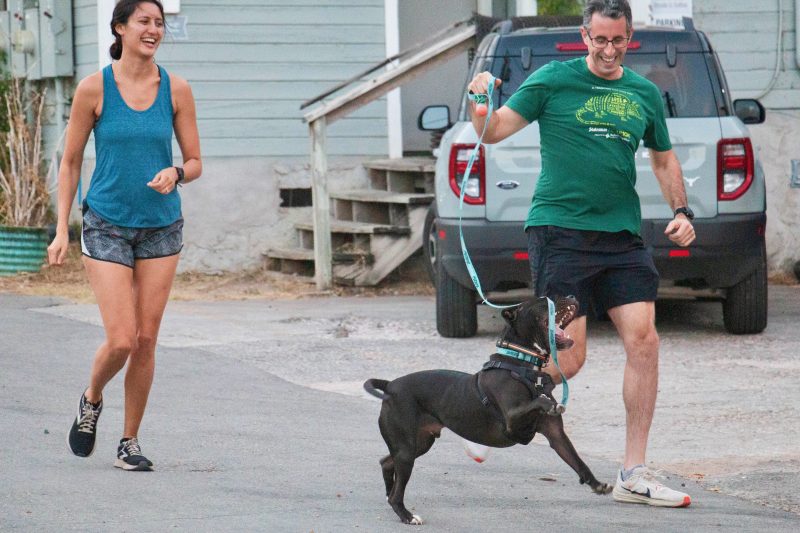Sole Mates: How Running Clubs Are Stepping Up When Dating Apps Stumble
By Luke Lawhorn
Reporting Texas

Sarah Spitler, left, and Matt Russo run with their dog at the Austin Beer Rub Club. They met through a running club and are engaged to be married. Luke Lawhorn/Reporting Texas
Sarah Spitler was ready to give up on dating apps after feeling nothing special was coming from her matches.
“I just felt they weren’t working for me,” said Spitler, who teaches high school in Austin. “After meeting someone one or two times, I never really felt like I had a connection with them.”
Then as the COVID-19 pandemic eased and people resumed social interaction, Spitler found the Austin Beer Runners group, where she met Matt Russo, a computer engineer.
“As things started to open up again, I’m like, I need to go meet people,” Russo said. “And run club was a way for me to do that, and I think there were a lot of other people that were like-minded.”
Their running club meeting led to three years of dating and now plans for a wedding in March.
Russo, 39, and Spitler, 27, join a growing number of people finding social connection in running clubs. Austin has 35 groups that link up each week for runs on city streets and the hike-and-bike trail around Lady Bird Lake, according to Austin Runnin. According to a research article from the Journal of Social and Personal Relationships, couples who workout together can improve their relationship.
Paul Carrozza, a longtime Austin running coach and founder of the RunTex running store brand, said he’s noticed the trend in dating within running groups.
“To me, it’s like a really cool, modern option,” Carrozza said. “I got people that are motivated and they’re going to be healthy because they’re out exercising so they’re doing healthy habits. And they’re not so hardcore and so worried about their time that they’re not having fun, which is good.”
For some, dating apps are hit-or-miss and users can become worn out by the overwhelming choice.
Lisa Neff, a University of Texas professor who studies adult relationships, says studies show that unlimited access to thousands of dating profiles can result in the user becoming overwhelmed. When people have too many options, they often make “bad decisions” focusing on qualities or aspects that don’t matter, resulting in users being less satisfied with their decisions.
“There’s too much choice,” Neff said. “It can just sort of make people shut down. There’s some research showing that people can get in what’s known as a rejection mindset. So the more profiles they’re scrolling through, the more likely they are to just start saying no to everybody because you just get fatigued.”
A reason for the potential success in finding a date in running groups is the common ground in their own health. Showing up to a club consistently can increase the likelihood of developing romantic feelings toward someone simply by having the shared similarity.
Neff said that people are attracted to others who are similar and feel familiar with them, which can mean it’s harder to be rejected.
“The more you’re exposed to someone, the more we tend to have favorable feelings toward them,” Neff said. “Having that familiarity with them can also make us feel more comfortable around them, feel maybe more an inkling towards positivity toward them.”
Jim Caruth founded the Austin Front Runners group in 1998 and met his partner Clay back in 2002 in the club. Like the others, Caruth was drawn to Clay’s commitment to fitness.
“I’m interested in health-oriented people, so it gives me a group of people I automatically have something in common with,” Caruth said.
Training together at a running group can also make it easier to set up future dates, at least it did for Spitler. Both she and Russo were signed up for a half marathon, leading Spitler to make the first move on Russo by asking him out for pasta the night before the race.
“It was less pressure for me to ask him out because I had an excuse,” Spitler said. “It was an easy way to build up my courage.”